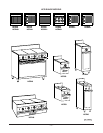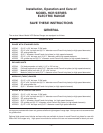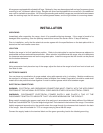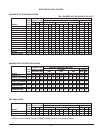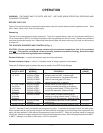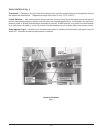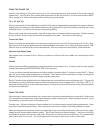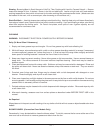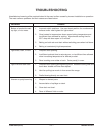
– 10 –
OPERATING HINTS
Preheat the oven and surface units to cooking temperature before cooking the product. Become familiar with
the function of the controls and the area of their operation.
Avoid excessive door opening. Also avoid direct air current on the oven.
Use flat-bottomed, straight-sided pots and pans.
Use covers for stock pot work. Water will boil much sooner and much less heat is required for cooking in a
covered container.
Turn high speed elements off a few minutes before cooking is completed to use the heat stored in the element.
After each cooking load, scrape excess food and fat particles off the griddle surface, using a flexible spatula or
wire brush.
COOKING TIPS
Oven
While it is recommended that the 3-heat switches be set to the HI position in order to preheat the oven to the
desired temperature, it is necessary for some baking products to turn the 3-heat switch controlling the top
elements to the MED or LO position in order to reduce the amount of radiant heat applied to the product so that
the top portion of the product will not be burned.
Uneven cooking may be prevented by different settings for the top and bottom oven 3-heat switches. The amount
of heat applied to a product inside the oven is affected not only by the setting of the thermostat and 3-heat
switches, but also by its position inside the oven and the frequency of opening and closing the oven door.
Meat roasting is best performed in a balanced oven; 3-heat switch positions of HI and HI are suggested, with
the thermostat setting at the low temperature recommended by the American Meat Institute and the Department
of Agriculture. Top heat results in a well colored or carmelized finish to meats. When roasting fowl and a heavily
browned appearance is not desired, set the top 3-heat switch at MED or LO. It is recommended that a meat
thermometer be used for all meat roasting operations.
Range Top
Typical cooking operations described below (plus many other types of pot-and-pan work) require quick changes
from high to low heats. With versatile Hobart range tops, you can maintain different sections at different
temperatures and just shift utensils from one section to another when you wish to change the speed of cooking.
Sauteing: Frying in Small Amount of Fat — Heat fat in a frying pan on high heat. When fat is hot, switch to low
heat and add food. Brown one side, turn and brown on second side. A flat-bottomed pan is recommended for
sauteing. If a warped pan is used, food will be unevenly browned.
Pan Broiling: Cooking Meats in Frying Pan — Heat frying pan on high heat. Rub hot pan lightly with fat or suet
to prevent meat from sticking. Add meat and brown on one side. Turn and brown on second side. Pour off fat
as it accumulates.
When cooking is completed, open oven door and unload product. After oven cools, any spills should be wiped
up as quickly as possible to prevent them from becoming stubborn stains.




